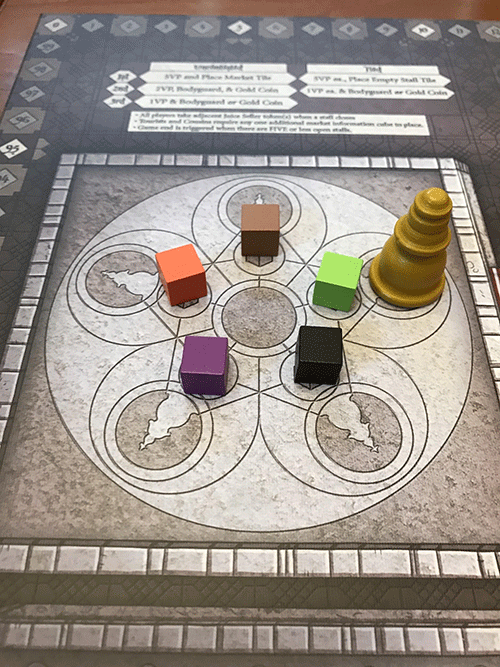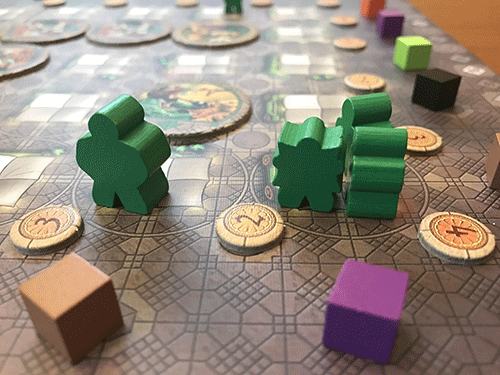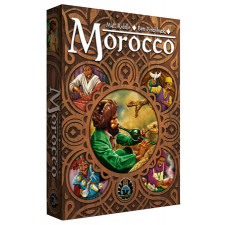Morocco Review
on Sep 29, 2016
The promised setting of Morocco is intoxicating. Family bosses crowd around each other from the rooftops of the Jemaa el Fnaa market, trying to decide which of the stalls below will be the most lucrative. After scouting, these snake charmers and water sellers jostle amid the teeming market for retail space in a sort of reverse Black Friday stampede. Bodyguards, cousins, and even tourists are thrust into a high stakes game of artisanal capitalism. The art on the tokens help to realize this world; you can almost smell the beets roasting on the green tiles. Unfortunately, the mechanics never quite complete the story and the game falls short because of it.

A beautiful presentation
There’s an arc to most board games both narrative and mechanical. Whether they’re slaying dragons or growing carrots, players start small and build themselves up. Some games race to the finish becoming ever tenser, while others see a rise and fall to both power and influence. Morocco does neither. Player’s options and abilities remain flat with no engine to speak of, and the ever shrinking board does little to add any sort of edge to the player’s decisions. The drama is nonexistent unless you’re a player who finds drama purely in ticking your score ever upward.
That isn’t to say that Morocco is bad. The base concept of scouting out the market stalls is a good one. The stalls in this market are arranged on a 5x5 grid with each row and column corresponding to a colored cube. An individual stall is defined by its intersection; placing an assistant in the stall that sits in Row Green Column Black requires spending – you guessed it – a green and a black cube. These cubes are acquired in the scouting phase where players take turns obtaining a couple cubes of their choice, and a few of their opponents’ choices. Additional cubes can be spent to use more powerful workers, from Bodyguards that help crowd opponents out to tokens that recruit a cousin to run to a nearby stall.
The scouting phase is rather clever and represents family bosses obtaining the knowledge they need to snag the best stalls. One cube of each color is randomly assigned to the 5 points of a pentagram-ish shape on the board. On your turn you place a marker on one of these points and claim one cube of each color adjacent to the point you chose. Your opponents get a cube that matches the selected point. I like this bit a lot, but it’s also the first place where the mechanic starts to poke through the thinly stretched theme. I may be able to see that the Green/Black stall is where I want to go, but unless both the Green and Black cubes are located on opposite sides of one of the other colors, I’m dependent on my opponent to hook me up with one of the cubes I need.

Black and Brown for me, Green for everyone else
It just doesn’t make sense with the presented setting and the more you play the more the theme peels itself off like a balloon popping in slow motion. Bodyguards, apparently content to posse up with less powerful families, are only available after you’ve come second or third in your attempt to control a stall. Tourists can be recruited to work a stall for you before converting into a standard assistant when that stall is closed - oh god am I kidnapping them? The ability to swap cubes around to change the grid orientation is critical to being able to manipulate the scouting phase, but why can I do that? Because it adds a needed level of control and strategy to the mechanics. Most of the above gripes add strategic depth, they just don’t make sense for the exotic world of Morocco.
Of course, one doesn’t typically look to a euro style game for a strong intersection of mechanics and setting. The primary reason it sticks out for Morocco is because the lack of a theme makes the lack of an arc or engine noticeable. Players never really get better at controlling stalls. You can only carry one cube forward round to round so there is little opportunity for judicious saving or explosive turns. It usually takes multiple rounds to claim a stall and the small combos you can set up are often telegraphed. Morocco has plenty of strategy available to those who can dig into it, but each game doesn’t feel compelling and lasts about 15 minutes longer than I want it to. With no story to carry it along or arc to drive your actions, the game becomes an exercise in following a game procedure and not playing a game. It almost feels like you’re playing a proof of concept for an admittedly intriguing mechanic. This feeling is especially strong at low player counts. The standard scouting phase would result in an insufficient number of cubes and so players supplement their “knowledge†via an arbitrary die roll.

Tourists and Bodyguards claiming space for the Green player
Morocco never really elevates itself beyond a collection of functioning mechanics. Unfortunately, mechanics are not games and games are more than mechanics. The core of Morocco is good. I like the idea of the scouting phase, where you have to balance your own desires with the desires of your opponents. I like the idea of the grid informing where you and your opponents can place their assistants and the small combos you can build. It’s just missing the sort of narrative or mechanical arc that makes me want to pull it off the shelf. It’s a fine game, but fine isn’t going to cut it in today’s gaming world.

 Customer Support
Customer Support  Subscribe
Subscribe 




 Account
Account  Wishlist
Wishlist 

